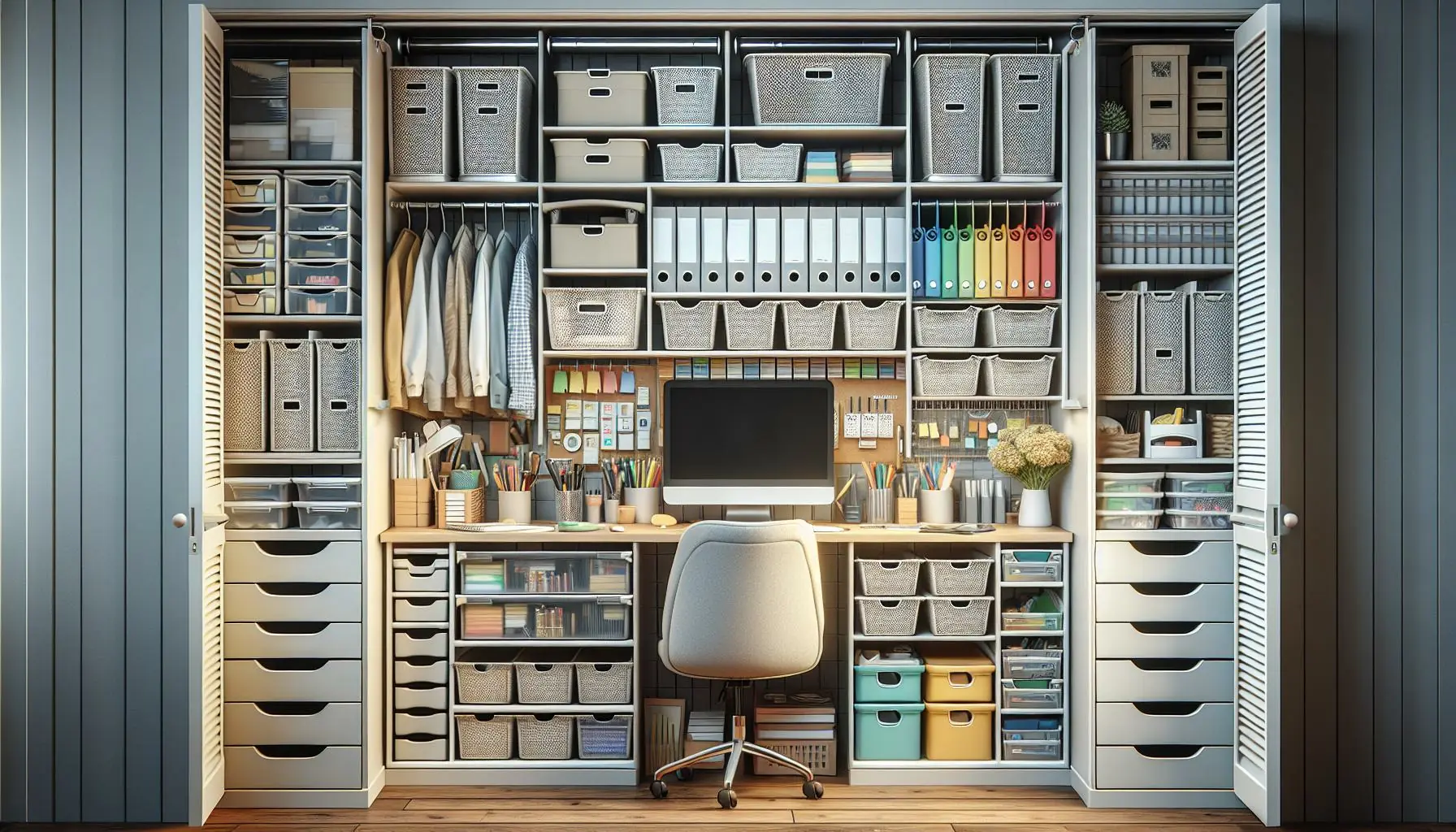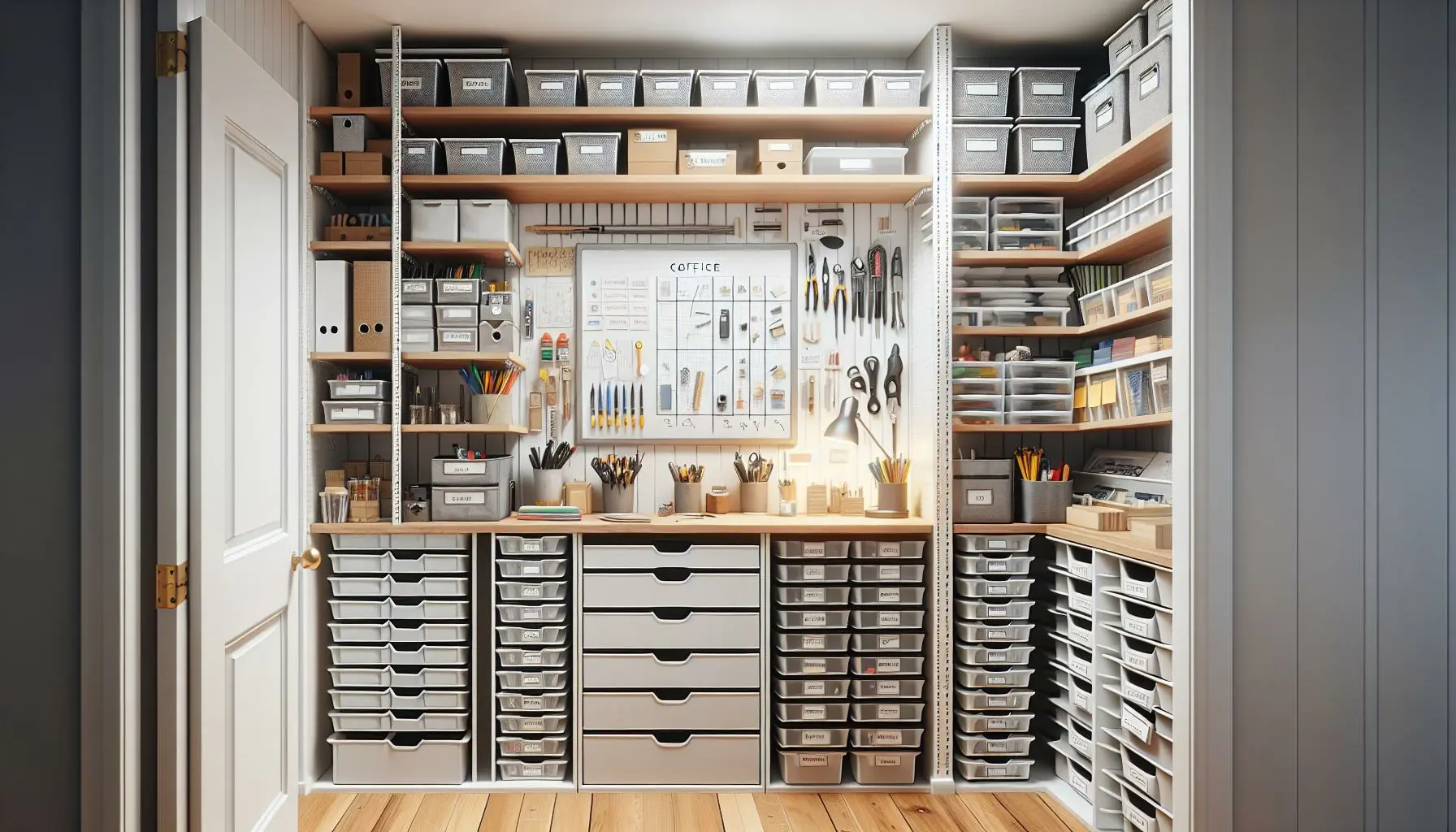Working from home has become the norm for many of us, and creating an efficient workspace is essential. One often-overlooked area is the closet, which can transform from a cluttered catch-all into a functional storage solution. Organizing your home office closet not only maximizes space but also boosts productivity and reduces stress.
I’ve discovered that a well-organized closet can serve as a sanctuary for all my office supplies, documents, and tech gear. With a few simple strategies, you can reclaim that space and make it work for you. Let’s dive into some effective tips that’ll help you turn your home office closet into an organized haven.
Table of Contents
ToggleKey Takeaways
- Maximize Workspace Efficiency: Organizing your home office closet optimizes space and enhances accessibility to essential items, leading to improved productivity.
- Reduce Stress: A clutter-free closet creates a calming environment that minimizes distractions, allowing for better focus and concentration while working.
- Use the Right Tools: Incorporating baskets, bins, adjustable shelves, and drawer organizers are essential for effective closet organization, facilitating easy retrieval of supplies.
- Implement a Systematic Approach: Follow a step-by-step guide that includes decluttering, categorizing items, and maintaining organization to ensure your closet stays functional.
- Regular Maintenance is Key: Schedule monthly assessments and tidy up after use to keep your closet organized and adapt to any changes in your workflow or supplies.
- Embrace Flexibility: Be open to adjusting your organizational systems and tools as your work evolves, ensuring your home office closet remains relevant and efficient.
Importance of Home Office Closet Organization
Closet organization plays a pivotal role in maximizing workspace efficiency. A tidy closet boosts productivity by providing easy access to essential items.
Enhancing Productivity
Organizing a home office closet significantly enhances productivity. A well-arranged closet eliminates the time spent searching for supplies or documents. When each item has a designated spot, I can focus on my tasks without distraction. For instance, I can categorize materials into folders, bins, or shelves, making it easier to locate what I need quickly. Implementing clear labeling systems assures that I’ll stay organized and minimize chaos during busy workdays.
Creating a Stress-Free Environment
A clutter-free closet contributes to a stress-free environment. When I can easily find important items, my mental load decreases, allowing for better concentration. An organized space creates a sense of control that calms my mind. Additionally, incorporating elements such as drawer dividers or storage boxes helps in segregating supplies, further reducing visual clutter. This organized aesthetic fosters a positive atmosphere, conducive to creativity and focus while I work.
Essential Tools and Supplies

Effective home office closet organization relies on the right tools and supplies. These elements help streamline the organization process, making it easier to find and access essential items.
Storage Solutions
- Baskets: Baskets of various sizes work great for holding smaller items like notebooks, pens, and cables. They enhance accessibility while keeping supplies contained.
- Bins: Clear bins provide an excellent way to sort and store larger office supplies. They allow for quick visibility, making it simple to identify contents at a glance.
- Shelves: Adjustable shelves optimize vertical space, accommodating different storage needs. These can hold books, files, or decorative items, contributing to a polished look.
- Drawer Organizers: Drawer organizers separate items within desk drawers. They prevent clutter, keeping similar items together for easy retrieval.
- Labeling Systems: Labels attached to bins or shelves enhance organization clarity. A consistent labeling system saves time, allowing for rapid access to necessary supplies.
- Dividers: Drawer dividers create distinct spaces for items, preventing them from shifting around. They keep everything orderly and simple to navigate.
- File Folders: File folders organize documents by category or project, reducing paper clutter. Color-coding files can aid in quick identification of important papers.
- Binder Clips: Binder clips secure loose papers together, keeping documents organized and preventing loss. They come in various sizes to accommodate different page counts.
- Magnetic Strips: Magnetic strips can hold tools or supplies, making items easily accessible yet out of the way. These are ideal for small metal items like scissors or clips.
- Whiteboards or Corkboards: Incorporating boards for notes or reminders helps maintain focus without excess paper. These tools enable easy updates and visibility for ongoing projects.
By utilizing these essential tools, one can turn a chaotic home office closet into a highly organized, efficient workspace.
Step-by-Step Guide to Organizing Your Closet

Organizing a home office closet involves a systematic approach that maximizes space and efficiency. Here’s how to proceed effectively.
Decluttering Your Space
- Remove all items from the closet to assess what’s inside.
- Sort items into three categories: keep, donate, and discard.
- Discard items that are broken or no longer needed, and donate items in good condition.
- Consider a regular decluttering schedule, such as every three months, to maintain organization.
Categorizing Your Items
- Group similar items together for easy access and visibility.
- Create categories such as office supplies, documents, tech accessories, and personal items.
- Use bins or folders to separate these categories, ensuring each category has its own designated space.
- Label each bin or folder clearly to improve accessibility and streamline finding items.
- Utilize adjustable shelves to customize vertical space according to item height.
- Incorporate drawer organizers and dividers to keep smaller supplies neat and accessible.
- Opt for clear bins for larger items, allowing for visibility of contents and reducing the need to rummage.
- Incorporate hooks or magnetic strips on the inside of the closet door for easy access to tools and accessories.
- Integrate a whiteboard or corkboard on the back wall for quick notes or project reminders, enhancing productivity.
Maintaining Your Organized Closet

Maintaining an organized closet demands consistent effort and mindful practices. By implementing a few strategies, I can ensure my workspace remains functional and free from clutter.
Regular Maintenance Tips
- Schedule periodic checks, aiming for at least once every month. Regularly assessing the closet helps identify any items that need decluttering.
- Tidy up promptly after using supplies. Returning items to their designated spots maintains order and keeps everything easily accessible.
- Assess label clarity regularly. If labels become faded or unclear, freshen them up to maintain efficiency.
- Replace bins and organizers as needed. Adapting my storage solutions to better suit my routine enhances the closet’s functionality.
- Limit newly introduced items. When adding new supplies, I can remove an item of similar size to prevent overloading the space.
- Reassess organizational systems during major workflow changes. As my projects or responsibilities shift, my organizational methods may require adjustment.
- Rearrange or rotate storage solutions according to frequency of use. Positioning the most-used items at eye level fosters immediate access.
- Update categories as my work evolves. Creating new labels or bins for different tasks keeps my space relevant to my current needs.
- Seek feedback from myself on the closet’s functionality. Personal insights can highlight areas for improvement.
- Embrace a flexible mindset. Adapting to new tools and storage options enables me to remain efficient and productive.
A well-organized home office closet can truly transform your workspace. By implementing the strategies I’ve shared, you can create an efficient storage solution that not only enhances productivity but also fosters a positive working environment.
Staying consistent with your organization efforts will keep your closet clutter-free and functional. Regularly assessing your system and making adjustments as needed will ensure that it continues to meet your evolving needs.
Remember that a tidy closet is more than just aesthetics; it’s a pathway to better focus and creativity. Embrace these practices and enjoy the benefits of a streamlined workspace.



